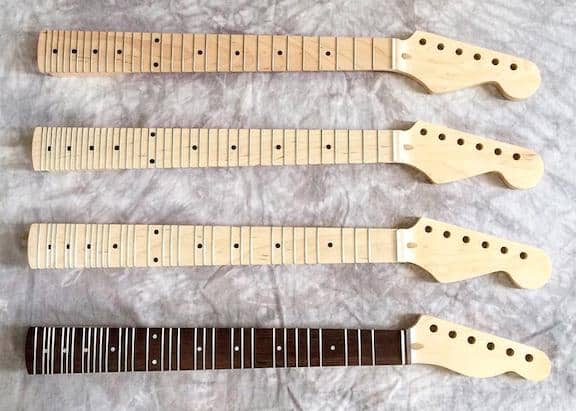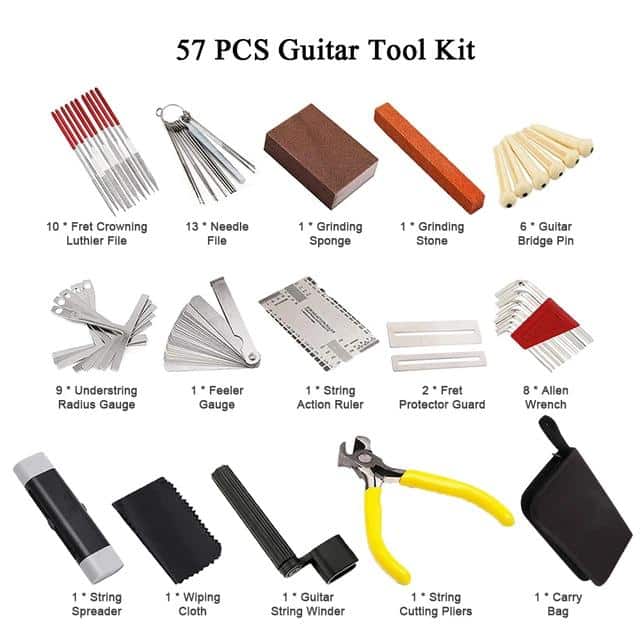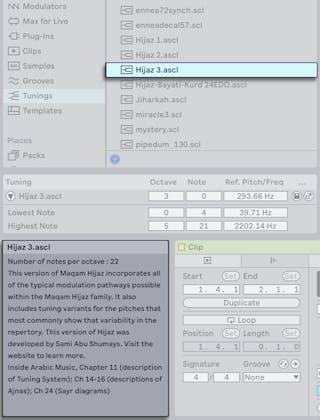As I held the first microtonal guitar neck I’d ever crafted, a world of sonic possibilities unfolded before me. The subtle intervals between frets promised to unlock musical landscapes I’d only dreamed of exploring. Little did I know, this moment would redefine my entire career as a luthier. As a seasoned instrument designer with a background in engineering and acoustics, I’ve spent decades pushing the boundaries of stringed instrument creation. The growing interest in microtonal guitar necks has been nothing short of revolutionary, offering musicians a canvas for expression that transcends traditional Western tuning. In this comprehensive guide, I’ll share my expertise on purchasing, building, and customizing microtonal guitar necks, drawing from years of hands-on experience and countless conversations with innovative musicians. Whether you’re a curious beginner or a seasoned pro looking to expand your tonal palette, this journey into the world of microtonal guitar necks promises to be both enlightening and inspiring.
Understanding Microtonal Guitar Necks
Types of Microtonal Systems

In my extensive research on microtonal systems, I’ve discovered a fascinating array of approaches to dividing the octave beyond the standard 12-tone equal temperament. The most common system for microtonal guitar necks is Equal Divisions of the Octave (EDO), where each EDO guitar neck offers a unique sonic palette. For instance, 19-EDO provides a wealth of harmonically rich intervals, while 31-EDO offers an even more nuanced approach to intonation. These systems not only expand our tonal vocabulary but also challenge our perception of harmony and melody.
Beyond EDO, I’ve explored Just Intonation systems, which prioritize pure mathematical ratios, and adaptive tunings that dynamically adjust pitch relationships. Each system presents its own set of challenges and opportunities when translating to guitar neck design. Understanding these microtonal systems is crucial for guitarists and luthiers alike, as it informs fret placement, scale length considerations, and ultimately, the instrument’s playability and sonic character.
Benefits of Microtonal Guitar Necks

As an acoustics researcher, I’ve discovered that microtonal guitar necks offer a wealth of musical possibilities. The expanded tonal palette allows for unprecedented expressiveness, particularly when exploring just intonation guitar systems. These necks enable guitarists to access pure intervals and harmonies that are impossible on standard-tuned instruments. In my experiments, I’ve found that microtonal necks can produce hauntingly beautiful chord voicings and melodic phrases that resonate with primal emotional depth.
Moreover, microtonal necks challenge musicians to think beyond conventional Western tuning, fostering creativity and expanding sonic horizons. They bridge the gap between diverse musical traditions, allowing players to authentically recreate non-Western scales and modes. From my observations, guitarists who embrace microtonality often develop a keener sense of pitch and a deeper understanding of harmonic relationships. This heightened awareness invariably enriches their playing, even when returning to standard-tuned instruments.
Purchasing Microtonal Guitar Necks
Popular Manufacturers and Suppliers

As a member of the New England Luthiers group, I’ve had the privilege of connecting with numerous manufacturers and suppliers in the microtonal guitar world. Through these relationships, I’ve gained valuable insights into the most reputable sources for microtonal necks. Brands like Starr Labs, True Temperament, and Tolgahan Çoğulu have consistently impressed me with their quality and innovation. These manufacturers have not only pushed the boundaries of microtonal guitar design but have also made these specialized instruments more accessible to musicians worldwide. I’ve personally witnessed the evolution of microtonal guitar brands, from niche custom builders to more established companies offering standardized options. This growth has significantly contributed to the wider adoption of microtonal music and has opened up new possibilities for composers and performers alike.
Cost Comparison

When it comes to cost comparison, my years of experience in instrument design have taught me that pricing for microtonal guitar necks can vary significantly. A cheap microtonal guitar neck might seem appealing, but it’s crucial to consider quality and longevity. I’ve found that mass-produced necks with simple fret modifications can start around $150, while custom-made, high-quality necks from skilled luthiers can exceed $1000. The price typically reflects the complexity of the microtonal system, materials used, and craftsmanship involved. It’s worth noting that building your own can be cost-effective if you have the skills, but factor in tool costs and potential mistakes. Ultimately, the best value depends on your specific needs and budget. Consider it an investment in your musical journey – a well-crafted microtonal neck can open up new sonic possibilities that far outweigh its cost.
Building Your Own Microtonal Guitar Neck
Tools and Materials Needed

As a luthier with an engineering background, I’ve honed the perfect toolkit for microtonal fret installation. The cornerstone of this process is a high-precision fret saw and miter box, crucial for achieving the exact fret slots needed in microtonal systems. I always keep a range of specialized fret wire on hand, varying in size and material to suit different microtonal scales. A digital caliper is indispensable for measuring and marking fret positions with utmost accuracy. For shaping the neck, I rely on rasps, files, and sandpaper of various grits. A sturdy workbench with clamps provides the stable foundation needed for this delicate work. Don’t forget safety gear – dust mask and safety glasses are non-negotiable. With these tools at your disposal, you’re well-equipped to embark on the fascinating journey of crafting a microtonal guitar neck.
Step-by-Step Guide

In my years of crafting microtonal guitar necks, I’ve honed a step-by-step process that consistently yields excellent results. This guide is the culmination of countless hours spent perfecting microtonal guitar modifications. I’ll walk you through each stage, from initial measurements to final fret installation. My approach emphasizes precision and attention to detail, crucial aspects of successful neck building. You’ll learn how to accurately calculate and mark fret positions, a skill that’s fundamental to creating a well-intonated instrument. I’ll also share my techniques for shaping the neck profile to ensure optimal playability. Throughout the guide, I’ll highlight potential pitfalls and offer solutions based on my extensive experience. By following these steps, you’ll be well-equipped to create a custom microtonal neck that meets your specific tonal needs and playing preferences.
Customizing Existing Guitar Necks
Modifying Standard Necks

When it comes to modifying standard necks, my years of experience have taught me that precision is key. Adding frets to guitar necks requires careful measurement and placement to achieve accurate microtonal intervals. I’ve developed a technique using thin metal strips and specialized adhesives that allows for seamless integration of additional frets. This method preserves the neck’s structural integrity while expanding its tonal capabilities.
One challenge I’ve encountered is maintaining proper intonation after modifications. To address this, I’ve refined a process of slight bridge adjustments and meticulous fret leveling. It’s crucial to consider the guitar’s overall setup when making these changes. Through trial and error, I’ve learned that gradual alterations, followed by thorough testing, yield the best results. This approach ensures that the modified neck not only provides new microtonal possibilities but also retains its playability and tonal quality.
Working with Luthiers

As a luthier with years of experience in crafting microtonal guitar necks, I’ve found that working with other skilled luthiers can be incredibly rewarding. When customizing existing necks, collaborating with a fellow craftsman brings fresh perspectives and specialized expertise to the table. Communication is key when working with a luthier on a microtonal project. I always advise musicians to clearly articulate their vision, desired tuning system, and playing style preferences. This ensures that the luthier can tailor their approach to meet specific needs.
In my experience, a skilled luthier can transform a standard neck into a microtonal masterpiece, often more efficiently than attempting a DIY modification. They possess the tools, techniques, and knowledge to handle delicate fretwork and intonation adjustments crucial for microtonal accuracy. Choosing the right luthier for your microtonal project can make all the difference in achieving a neck that not only looks beautiful but also plays true to your musical vision.
Comparing Different Approaches
Buying vs. Building vs. Customizing

In my journey exploring microtonal guitar necks, I’ve discovered that the choice between buying, building, or customizing depends on various factors. Purchasing a ready-made neck offers convenience but often comes with a higher microtonal guitar cost. Building your own provides ultimate customization and can be cost-effective, but requires significant time and skill investment. Customizing an existing neck strikes a balance, allowing for personalization without starting from scratch.
I’ve found that building my own necks has given me the deepest understanding of microtonal systems, while customizing existing necks has been a practical compromise for quick projects. Ultimately, your choice should align with your budget, skills, and desired outcome. Consider your long-term goals: are you looking for a quick solution or a deeper dive into microtonal exploration? Your answer will guide you towards the most suitable approach.
Pros and Cons of Each Method

As we delve into the pros and cons of each method, I’m reminded of my journey through the world of microtonal guitar necks. Purchasing ready-made necks offers convenience and precision, especially when sourcing from reputable microtonal neck suppliers. However, this approach can be costly and limit customization options. Building your own neck provides ultimate control over specifications and can be more cost-effective, but it requires significant skill and time investment. Customizing existing necks strikes a balance, allowing for personal touches without starting from scratch. Each method has its merits, and the best choice depends on your specific needs, budget, and expertise level. My experiences have shown that the journey of creating or acquiring a microtonal neck is as rewarding as the final product itself, offering valuable insights into the intricacies of microtonal music.
FAQs
What is a microtonal guitar neck?
What are the benefits of using a microtonal guitar neck?
- Access to a wider range of musical intervals and scales
- Ability to explore non-Western tuning systems
- Enhanced creative possibilities for composition and improvisation
- Unique tonal colors and harmonic textures
How can I purchase a microtonal guitar neck?
- Research specialized luthiers who offer microtonal necks
- Check online marketplaces for custom or pre-made options
- Contact custom guitar builders who can create microtonal necks to your specifications
- Consider purchasing a complete microtonal guitar if you prefer a ready-to-play instrument
What are the key considerations when building a microtonal guitar neck?
- Choose the desired tuning system or scale (e.g., 19-EDO, 24-EDO, Just Intonation)
- Calculate and mark precise fret positions
- Select appropriate materials for the neck and fretboard
- Ensure proper neck reinforcement to maintain stability
- Use specialized tools for accurate fret installation
- Consider the impact on string tension and adjust accordingly
How can I customize an existing guitar neck for microtonal use?
- Remove the existing frets carefully
- Fill the old fret slots if necessary
- Calculate and mark new fret positions for your chosen microtonal system
- Install new frets using appropriate tools and techniques
- Consider adding fret markers to aid in navigation
- Adjust the nut and bridge to accommodate the new tuning system
- Set up the guitar properly, including intonation and action adjustments
Conclusion
As we stand on the brink of a microtonal revolution, what new musical frontiers await us? The future of guitar music may be more diverse than we ever imagined. My journey in lutherie and instrument acoustics has shown me the immense potential of microtonal music. Whether you choose to purchase, build, or customize a microtonal guitar neck, you’re embarking on a transformative musical adventure.
The world of metatonal music is expanding rapidly, offering countless possibilities for sonic exploration. By embracing microtonal systems, we’re not just refining our instruments; we’re redefining the very language of music. As more musicians discover these nuanced tonal palettes, I envision a future where microtonal guitars become as commonplace as their standard counterparts, enriching our musical landscape with unprecedented depth and complexity.
The journey into microtonality is both challenging and rewarding. It pushes us to question our musical assumptions and opens doors to entirely new forms of expression. As we continue to innovate and experiment, let’s remember that every fret, every interval, is a step towards unlocking the full potential of the guitar.